 Category: Viticulture
Category: Viticulture
February is the new April
How time flies. It’s been nearly two years, almost to the day, since I last wrote on this blog. And in 2015, when I posted that story, February was a different kind of month; not just cold, not just bitterly cold, but so cold that we wondered if our vineyard would survive the night. The forecasts said temps could reach minus 13 degrees on the night of February 20, and that was scary.
Vines can survive freezing weather without a problem, especially if they’ve had time to harden off (which requires some cold weather) before the big chill. They can withstand temperatures down into the teens and even below zero. But negative 13 degrees, which is what was forecast two years ago? That’s a killing freeze.
So flash forward to this February. We had two kinds of flowers blooming on our property, and I saw cherry trees and forsythia in full bloom last week. We spent evenings on our deck, not just to enjoy the spectacular weather, but to avoid having to turn on the air conditioning.
And our vines? Well, let’s just say I’m praying for them.
We had some colder weather move in, and the overnight lows were close to freezing. But daytime temps were well above 50 degrees every day, and that’s when vines start coming out of their winter slumber. At some point, the buds swell, then break, and then start sending up shoots. That’s when they’re vulnerable. A late frost in April or, for that matter, a normal frost in March, could threaten much of this year’s crop.
That happened last year. Shortly after budbreak, about the time that the shoots were an inch or so in length, we had two days in which the temperature dropped below freezing in the very early morning, killing a significant share of the primary buds on all of our vines. The secondary buds seemed to survive, and they sent up shoots. But those buds aren’t even remotely as fruitful as the primary buds.
We lost most of our crop. We might have had 35 gallons of wine in 2015, and perhaps 20 percent of that in 2016. Other vineyard managers i spoke to around the state relayed similar experiences.
So, what to do? Well, there are lots of ways to protect vines from late frost events, most of them very expensive. Some vineyards light fires, others spray water over the vines. (When water freezes, it releases heat. The only problem is that you need to spray water for the duration of the frost event.) Other vineyards rent helicopters to fly over the vines, forcing warmer air down. Of course there are only so many helicopters available on any given night, and they aren’t cheap. Maybe for our small hobby vineyard we could buy a big drone to fly over the vines.
As it happens, the annual winter technical meeting of the Virginia Vineyards Association began last week, and the unseasonably warm weather was a definite topic of conversation. In fact, one of the sessions was all about using sprays to combat late frost.
Michela Centinari of Penn State University discussed two in particular: Amigo oil, which can be used to delay budbreak, and KDL, which may lower the freezing point of vine cells. Both approaches seem promising, and I think we might lay in a stock of KDL for next year.
But for now we have one more trick up our sleeves that could work – late, or delayed pruning.
Each year, while the vines are still dormant, we prune to get them ready for the growing season. We mostly use a technique called cane pruning, which involves taking a shoot from the previous season and laying it down on the fruiting wire. That shoot, now a cane, will send up new shoots that will bear fruit.
The second, which we employ on some vines, is called spur pruning. Instead of laying down a new cane, we trim the shoots on the old cane to two or three buds, each of which will send up a new shoot that will bear fruit. Some will get pruned off during the growing season.
What’s important here is that the process of pruning stimulates growth. Many vineyards have begun employing a process known as double pruning, in which they trim away the clutter during the winter, saving the final pruning until later in the Spring, when they hope the danger of frost is past.
Obviously, that’s a very labor intensive approach, and not every vineyard can double prune. But we’re managing some 225 vines, and they can be pruned in a couple of days. So, we can afford to wait.
So that’s our approach for this year, and probably every other year going forward. If February is the new April, then procrastination is our new friend.
The Big Chill — We Felt it through the Grapevine
It takes years of hard work to establish a vineyard, but only one bad night to lose it.
A week ago Wednesday, I thought that night was upon us. With subzero temperatures in the forecast, it seemed as though we might have been on the verge of losing our little hobby vineyard, which has been the focus of so much of our time and energy for the past four years.
To jump to the end of the story for just a moment, we spent a long day working in the vineyard on Thursday and a long night of checking the temperature on an hourly basis and begging the climate gods to show some mercy. And when I climbed out of bed Friday morning, I was feeling much more optimistic. We won’t know for sure until later in the year, but I believe that our vineyard survived, though not without some degree of injury to the vines.
We had known for several days that severely cold weather was on the way, but it had seemed as though it would be manageable. We monitor a number of weather services – WxRisk, Weather Underground, and the Weather Channel among them – and the latter two provided forecasts that varied daily. (They also vary between each other. Sometimes I pick the one I like best and lull myself into a false sense of security.)
So, the outlook for early Friday morning looked very different on Wednesday than it had only a few days earlier. Negative five degrees had been scary enough. But I was really surprised to see forecasts that warned of temperatures as low as minus 13 degrees Fahrenheit.
Now, our vines can do just fine in freezing weather, and they’ll even manage through sub-zero temperatures. At some point, though, you can expect injury. Everything I’ve read – I’ve never experienced it, but I’ve done a fair amount of reading – suggests that at negative five degrees we should expect to lose at least some of the buds that would produce shoots and grapes in the coming growing season.
And at negative 13?
Well, the damage could be catastrophic. Buds are more sensitive to the cold than trunks and canes, but only by a few degrees, according to Virginia Tech’s Tony Wolf, who was good enough to put out an alert Wednesday with lots of information about the effect of freezing weather on vines.
Losing a significant number of buds and part of next year’s harvest would be bad news. But it’s one thing to lose part of the crop and quite another to lose the entire vine. At some temperature, the scion – the actual vine, which is grafted onto rootstock – could be killed. If that happens, there’s little alternative but to replace the vine.
That would be disastrous for anyone, and my heart goes out to commercial vineyards that might have lost either a substantial portion of the 2015 crop or some part of their vineyard. For them, it’s everything. For us, it’s a hobby, not our livelihood, so it would be incredibly self-centered for me to complain too much about our potential loss.
Having said that, though, the prospect of losing vines hit me on a very personal level. We’ve spent more than four years getting to this point, and I feel like I remember almost every minute of the hard work and sacrifice.
But forget, for a moment, about the time we spent taking classes, reading and talking to vineyard managers to learn everything we could about viticulture. And forget about the cash outlays. Let’s also put aside the hours of physical labor that went into establishing the vineyard. (Well, not too far aside – I can still remember a day last summer, working five hours with a backpack sprayer and thinking I was just about ready to die by the time I finished.)
As important as all those things are, what matters most to me is the time – the number of years it takes to order vines, plant them, and nurse them through to their first harvest. We all have only so much time in this life. And that means we get only so many chances to get it right.
So yes, we could start over again. We could order vines, but we wouldn’t be able to get the vines we want this year, so we wouldn’t be able to plant until the spring of 2016. And it would be another three growing seasons before we harvest again. That would bring us to the fall of 2018, which seems like forever.
We did have a couple of things going for us. First, we had a couple of weeks of freezing weather leading up to the big chill, which helped harden off the vines. That meant they should have been able to withstand lower temperatures than would have been the case if the deep freeze had hit all at once.
Second, we had a blanket of snow on the ground. Snow has an insulating effect, and if it’s deep enough, it can protect the graft union, where the scion is joined to the root stock. In our first two years, we had hilled up around the vines, creating a mound of dirt a couple of inches above the graft union to provide the same kind of insulating effect. This year, with the harvest and all of the time and labor that goes into fermenting five different varieties of wine, we just didn’t get to it. Lesson learned.
Third, we’ve planted varieties that are reasonably cold-hardy, including Cab Franc, Petit Verdot, Petit Manseng, and Viognier. The exception is Merlot, which is much more sensitive to cold injury. The Merlot is also the youngest of the varieties we planted and therefore the least able to take winter’s punch.
For all that, though, we were pretty worried. By the end of the day Wednesday, the Vineyard Goddess and I had decided to spend Thursday doing everything we could to protect the vines. Our plan was to use mulched and partially composted leaves and grass to hill up around each vine, in the hope that we could insulate the graft union to the point that we could save the vine, if not this year’s harvest.
We traveled to Afton Wednesday night so that we could get an early start the next morning. Sometime around 8 a.m. Thursday we made our first foray into the vineyard. It was about 3 degrees above zero and the wind was blowing. I was colder than I think I’ve ever been in my entire life, and we went back inside to add a couple of layers of clothing, have a cup of coffee, and wait for the temperature to reach a more civilized 6 degrees or so.
By 9 a.m., we were working in earnest. Over the years, I had dumped a large volume of leaves and grass clippings into a heap on the other side of our property, and we had a very large pile by this point that was just waiting to be repurposed. I used the front-end loader on my tractor to haul them into the vineyard where the VG mounded them around each vine. Here and there we added some snow to pack the mulch down, but mostly, we relied upon the organic matter to insulate the vine.
The overnight temperature readings were somewhat milder than the forecast, but they were still pretty severe. At 7 a.m., the temperature hit minus 6.1 degrees, according to the Weather Underground station closest to us. I would have preferred to have our own weather equipment in the vineyard, but this station is not only close, it’s also at the same elevation as our vineyard, so I expected that the readings would be very close to what we would have gotten if we had a thermometer on our own property.
In the next week or so, we’ll be sampling buds and canes to see how well we survived the big chill. This is a first for us, and I have no idea how we did. But I can say this: I feel a whole lot better because of the work we did. Even if we lose the vineyard – which I think is a low probability outcome – I’ll feel better knowing that we did everything we could. If we had done nothing at all and lost only half the vineyard, I would feel much worse.
Wine grape growing is agriculture and like farmers everywhere, we live at the mercy of whatever Mother Nature throws at us. As Chris Hill, one of Virginia’s vineyard pioneers, told me during one of our classes – and this is a major paraphrase – the averages (temperature, etc.) are important, but it’s the records that kill you. And this year was one for the books.
Saving Our Grapes from Birds and Other Predators
Last year, as we approached harvest time, I was admiring our grapes one weekend day when I realized it was time to check the sugar levels. Unfortunately, I had left my refractometer in Fairfax, which, well, wasn’t very helpful. But not to worry. I made a mental note to bring it with me to Afton the following weekend, when I was sure that the sugar in the grapes would be just about perfect.
I remembered the refractometer, but unfortunately, I could not find the grapes. I searched the Petit Verdot rows, where I was sure I had seen small clusters hanging, and the Cab Franc rows, which I knew also had grapes hanging from the vines. But there were none to be seen.
It was kind of like the time my car was stolen at the train station in Jersey. I stared at the space where my car used to be wondering why it was no longer there, and then wandered around the parking lot as though I hoped it was magically somewhere else. Somewhere other than where I knew I had left it. Self-delusion is a terrible thing.
My car was gone, all those years ago, and last year, so were my grapes. My first thought was birds. Yeah, they love grapes, and they know when they’re ripe. They descend upon the vineyard just at the time when the brix (a measure of the sugar level) is just right, and they steal everything in sight.
Of course, it could have been other predators. It seems that all of nature has its eyes on grapevines as the harvest season grows near, and so the vineyard manager needs to be alert. Raccoons love grapes, as do squirrels and bears and crows and turkeys. As it happened, our neighbors told us about a bear they had spotted wandering through our property last year, right around the time we found a huge gash in our deer fence. Jim Parkhurst of Virginia Tech told the summer technical meeting of the Virginia Vineyards Association that a bear will sit down in the vineyard, pull clusters of grapes off the vine, and then move down the row, sit again and pull off more clusters.
But, of course, it’s hard to know for sure which predator stole my grapes. Last year was a very difficult year because of the acorn shortage. There are two types of acorns; those that come in every other year and those that come in annually. In 2013, both types failed. So squirrels especially were desperate for a meal, and vineyards were like the free sample aisle at Costco. I talked to vineyard managers who reported losing more than a third of their grapes to predators last year, which is extraordinary.
So, this year, we’re all taking precautions.
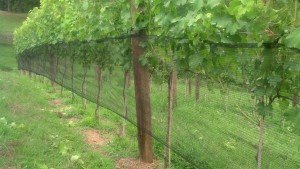
This is more or less what the netting will look like once it’s dropped. Here’, I’ve just attached it to the first catch wire on the Viognier vines, and haven’t yet rolled it up.
I spent the day Sunday (after a full day Saturday working with the Vineyard Goddess on canopy management) installing bird netting. Bird netting places a barrier between the grapes and predators, and hopefully it will be enough to preserve this year’s crop. I got about half-way through the vineyard, hanging the netting on my Viognier and Petit Verdot, and then rolling it up so that it will be out of the way until it’s needed.
I should point out that I would have also gotten the netting up on my Petit Manseng except that the Vineyard Goddess had found – I can’t even bring myself to say this – a bird nest in those rows, and asked me to wait a week or two. I wanted to rip the nest out, but I couldn’t. She’s the Vineyard Goddess, after all, and she outranks me when we’re working among with the vines.
As it turned out, I wouldn’t have gotten that far anyhow. I ran out of clips before I was quite through the Merlot, and I ran out of energy before I got to the Cab Franc. So, I ordered more clips today from Spec Trellising, and I’ll be praying next weekend that I don’t run out of netting. The roll that they shipped is 1,650 feet long, which should give me a couple of feet to spare. But who knows.
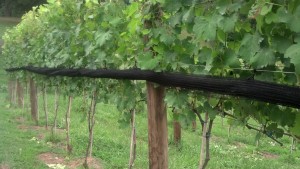
Here’s what the netting looks like after it’s rolled up, waiting until the grapes are ripe enough to attract predators.
A couple of words of advice to the weekend vintner about installing bird netting. First, don’t expect instructions. Apparently the netting doesn’t come with any. And don’t expect advice on how to install it – I didn’t get much. Also, don’t think the Internet will be of any help. I googled side-netting, bird-betting and every conceivable permutation of those terms for hours and got no help whatsoever. I did find lots of helpful advice, videos included, on different kinds of netting, especially the stuff that hangs over the trellis, creating a ceiling of sorts that you can drive a tractor underneath. But nothing for my side netting.
As it turned out, though, much to my surprise, bird netting isn’t all that hard to install.
Once I got the netting into the vineyard, and looked at the net clips, I was able to figure out (after one false start) how to do it. The clips look like tiny boat anchors, with a hook at the top to hold it to a catch wire and one hook on each side at the bottom. What I finally realized is that the back hook holds the netting on the catch wire permanently, and the front hook holds the rolled up netting (the storage position) until it’s ready for use.
I have lots of other questions, but I’ll figure it out as I go. And I ordered one more piece of equipment – small “C” hooks, which will hold the netting together at both the top and bottom to keep birds from finding a way in. I also have a tagging gun which is supposed to be a good way to zip shut the net at the bottom, but truthfully, I couldn’t figure out how to make the gun work this weekend.
I’m feeling pretty good about the netting, though. Unlike last year, I think most of my grapes will make it through to harvest. And if they don’t, it will be for reasons other than birds and other predators.
And, this is my first real harvest. As upsetting as it was to see my grapes stolen by predators last year, the fact is, it wasn’t that much of a loss. We had dropped fruit during the year to give the two-year old vines a good start in life. We wanted their energy to go toward developing a strong trunk and root system, not grapes. So, for those of you wondering exactly how many grapes were stolen, the answer is something like a half-dozen or so clusters that we missed when dropping fruit.
Not the end of the world, thank God. More like a cheap lesson for the future.
If we’re winter pruning, then Spring must be close
Maintaining a vineyard is a year-round enterprise. Even in the winter, after the vines go into a dormant state, there’s work to be done. In fact, dormant winter pruning is among the most time-consuming work of the year, and some of the most important as well, since it involves decisions that will affect not just the coming season’s growth, but the year after as well.
Most of the objectives of dormant pruning fall under the heading of “balance.” Vines will grow just fine on their own, with no pruning at all, but most of their energy will go toward producing shoots and leaves, rather than grapes. Absent any intervention, the vines will continue to grow skyward for so long as they can find support. The whole purpose of a trellis system and the pruning decisions that go with it are to force the vine to direct its energy toward the production of high-quality fruit rather than vegetative growth.
So we’re looking for balance as we decide which shoots and how many buds to retain. Prune away too much and the vine will be undercropped, producing less fruit than it can reasonably support. Prune away too little and it will be overcropped, producing a profusion of leaves and shoots, as well as an abundance of fruit that is destined to be of low quality.
During the growing season, we’ll drop some fruit from the vine, again to direct energy toward the remaining clusters in the hopes of producing more concentrated and higher-quality grapes. But the first decisions we make that will determine the quantity and quality of the season’s fruit are those made in the dead of winter.
Which is to say, when it’s cold outside. Really, really cold. Not to mention snowing every few days or so. (Or maybe it just seemed that way this winter.) Which is one of the reasons we’ve put off pruning.
The other, more noble reason for delaying our pruning, has to do with timing. It’s better not to prune too early in the season – the untouched vines will survive a cold spell much better than those that have been pruned back, and by waiting, you’ll have more options in the case of a late freeze that damages buds and shoots.
It’s helpful to be able to assess the vine late in the winter for cold injury before deciding which canes to remove and which few to retain. In our little hobby vineyard, we have the luxury of delaying for almost as long as we want to start dormant pruning. Commercial vineyards that have acres of vines to prune, don’t have that luxury. They need to start early enough to be able to finish the job before budbreak. But many vineyards employ a technique of double pruning, going through once early in the winter to trim away the shoots they know won’t be used, and returning later to finish up the job.
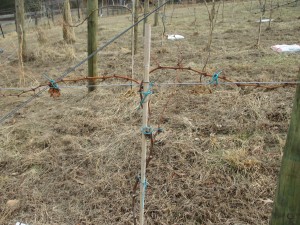
This cane-pruned vine is finished on the left arm, only partly done on the right. Click on the picture for a better view.
Our vines are all trained to a trellis system known as vertical shoot positioning, of VSP, and we have adopted a pruning method known as cane pruning. In cane pruning, most of the previous year’s growth is pruned away, and two one-year old shoots, which have now achieved the status of canes, are retained and trained in either direction along the bottom, or fruiting wire. These canes – the one-year old wood – will give rise to new shoots this summer, and these new shoots are the part of the vine that will bear fruit.
At the same time, we’ll be looking for renewal spurs below this year’s fruiting canes. These will be pruned back to one or two buds to provide the fruiting canes for the following year.
I’ve taken a class or two on pruning, and I’ve done lots of reading and studied more videos on the Internet than I can count. So, of course, I should be an expert. And in theory I am. I know a lot about the why’s and how’s of pruning. But the actual pruning – the time when you come face to face with a vine and decide what to lop off and what to keep – that’s a whole different story. I still remember my first pruning session. I was sure that I was going to destroy the vine, and I stared at it for what seemed like hours before I worked up the nerve to make that initial cut. I’ve gotten a little more confident, but only a little. I still spend way too much time on each vine. Fortunately, we only have 230 vines now, so I can get away with it.
When the Vineyard Goddess and I got out a few weeks ago – and yes, we chose a weekend when the temperatures were in the 60s – we realized that we had not maintained the vines as well as we should have in the previous year. No neglect, just the kinds of mistakes you make early on. A number of the vines were just fine, but others lacked the kind of year-old shoots we were looking for to train to the cordon wire.
So, we made some adjustments. On the vines that had perfect one-year old shoots, we cut away everything else and tied these canes down. On those that didn’t, we resorted to a different pruning method called spur or cordon pruning.
In spur pruning, a cordon is tied down to the wire and used year after year. The shoots from the previous year are pruned down to two buds, which will give rise to fruitful wood for the current season. It’s more like a haircut, and most people would say it’s a far easier method of pruning than cane pruning. And it works well for at least the first decade. At some point, however, these cordons grow thick from age and produce fewer spurs. Moreover, they’re more prone to disease. It’s the same with people. The older you get, the more opportunity your body has to develop diseases.
Which method is better? Well, they each have advantages and disadvantages. Jim Law, founder and owner of Linden Vineyards, said he started with spur pruning, which worked well for years, but eventually moved to cane pruning, after the disadvantages – disease in particular – began to outweigh the advantages.
Our thought, however, is that we’ll spur prunes those vines that need it this year, while leaving some buds that we hope will give rise to canes that can be trained to the wire in 2015. And while I remain hopeful that our vines will produce some wonderful fruit thisyear for making wine, I am confident that we’ll do even better next year and better still in each of the succeeding years. After all, this is a learning experience, and Lord knows, we’re learning.
A Tough Year for a Weekend Vintner
It was a tough year to be a weekend vintner.
When you’re separated from your vineyard by a two-hour drive, you have to make the most of your time. And we try. But the weekends are short, and there’s so much to do. And every curve that Mother Nature throws your way puts you just a little bit further behind. This year, Mother Nature was throwing curves, sliders, and the occasional spitball.
This year began with a late spring frost, followed by rain. Not just a little rain, but lots of rain, which gave rise to all kinds of fungal disease potential. Powdery Mildew, Downey Mildew, Botrytis, you name it.
And then came the pests: Japanese beetles, birds, raccoons, squirrels, deer, and even bears. Yes, indeed, bears. No lions or tigers,though. Just birds, deer and bears. And yeah, racooons and beetles and the rest of the pests.
That’s one of the reasons I’ve not been able to pay much attention to this blog. Another was that Chris and I took on responsibilities for editing Grape Press, the quarterly publication of the Virginia Vineyards Association. But mainly it was the challenges of the growing season. It seems like we spent all of our spare time each weekend keeping up with the vineyard. Spraying, cultivating, pruning, and spraying. Yeah, lots of spraying. It wasn’t easy.
Let’s start with the late frost. I remember arriving at the vineyard early one Saturday morning to find our whites all but devastated. Honestly, it looked as though someone had sprayed Round-Up and left them to die. For a while, I actually wondered if they had been the victims of spray drift from the herbicide we had used to clear a row for new the new vines we had planted this year.
Fortunately, that was not the case.
After checking the temperatures recorded nearby, I realized that we had probably experienced at least one and possibly two frost events in which temperatures had dropped just below freezing for a few hours in the early morning. My reds were fine, but they are planted higher on the slope and there’s a good possibility that temperatures stayed a degree or two higher in their part of the vineyard. Alternatively, bud break came earlier for the whites and they may have just been victims of bad timing. I’ll never know.
It turned out okay, though. Both the Petit Manseng and the Viognier had enough secondary buds left to generate growth for this year. Within a few weeks, we were seeing buds break and shoots begin to develop. And by the middle of the summer, they were looking like grape vines again. So, all was well.
But then it started to rain. Continue Reading–>
Where Did the Grapes Go?
Five days ago, at the end of the holiday weekend, I was thrilled with the progress of our vines. We hadn’t allowed a lot of grapes to accumulate, given that the vines were only in their second year, but we had left a few clusters, and they looked beautiful. Moreover, they tasted amazingly sweet.
Alas, last weekend I had left my refractometer at the other house, and so I couldn’t measure the Brix, which would have told me how much sugar had accumulated in the grapes and therefore the potential alcohol. Not essential, given that we weren’t planning to make wine from this grapes, but it would have been nice to know. But I told myself, it’s Monday, I’ll be back on Friday, and I’ll be able to measure the Brix on Saturday morning. What could go wrong with that?
Well, of course, lots of things could go wrong. But what I wasn’t expecting when I returned this weekend was to find the grapes gone. Yes, gone. As in, missing. As in, virtually none of them left on the vine.
It turns out I was right about one thing. The grapes had ripened and accumulated a decent amount of sugar. Which meant that they were not only close to being ready for the crush, they had become attractive to lots of the critters that roam through the country near our vineyard. Birds, deer, badgers – who knows? Almost any animal cruising near our property could have decided to chow down on our grapes.
So, a few lessons.
First, we didn’t lose quite all the grapes. I had put bird netting up around some of the Cab Franc vines a few weeks before, and those grapes were largely intact. I measured the Brix and it came in at about 21.2 percent. Not bad. Not quite ready for the crush pad, but getting there. It’s been a horrible year with the rain and dark skies, but another week or two in the sun (assuming we get a week or two of sun) and they might have made pretty decent wine.
Second, among the grapes we didn’t lose were those in the “mother vineyard.” These are the Cab Franc vines we had planted in the first year before we even knew where the main vineyard would be located. We had purchased them for practice and never even really considered that we’d use them for wine. These, the critters left alone.
But why? Well, when I measured the Brix it was at about 16 percent. Not even remotely ripe enough for wine. So maybe these grapes were ignored because they weren’t sweet enough. Apparently the critters that hang around our property are pretty choosy in what they bite off. Continue Reading–>
Just off the Grape Press: New Editors
It’s a pleasure to announce that the Vineyard Goddess and I are now co-editors of Grape Press, the quarterly publication of the Virginia Vineyards Association. Our first issue is the just-published Spring 2013 edition, and while we took over editorial responsibilities too late to have had any role in the planning, we spent lots of time collecting articles, working with the authors on final edits, revamping the look of page 1, and dealing with the hundreds (well, dozens and dozens) of little details that come up as you’re going to press.
We’re very excited about this opportunity for a number of reasons. First, lots of folks in the Virginia viticulture community have been 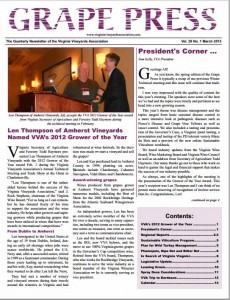 very generous with us, giving hours of their time to assist in our education. Early on, for example, I posted a note to a web site for the Central Virginia Winemakers group asking a question about how much time I should expect to set aside to manage a small vineyard I got lots of responses, and two of the folks who replied to my query hosted us at their vineyard for what amounted to a seminar on growing grapes.
very generous with us, giving hours of their time to assist in our education. Early on, for example, I posted a note to a web site for the Central Virginia Winemakers group asking a question about how much time I should expect to set aside to manage a small vineyard I got lots of responses, and two of the folks who replied to my query hosted us at their vineyard for what amounted to a seminar on growing grapes.
Secondly, we’re big fans of Virginia wine. We attended our first Virginia wine festival some 25 years ago, and while the wines weren’t great back then, some were pretty good, and we thought they all had promise. We were right. The wines got better each year, and today, we think Virginia wines have really come into their own. Virginia Viognier is a world-class wine. Cab Franc, Merlot, Petit Verdot, Petit Manseng, Norton and a number of other grape varieties have been made into truly great wines. My personal view is that a number of the Commonwealth’s wineries are making wines that can compete anywhere in the world, and their ranks are growing each year.
A major reason for the continued improvement in Virginia wine is the quality of the fruit that wineries have to work with. As the old saying goes, wine is made in the vineyard. And the quality of the fruit is improving in no small part because of the willingness of so many in the business to help each other out. In this industry, people share knowledge. Grape Press is part of that process, and the Vineyard Goddess and I are thrilled to be able to play a part, however small, in the continued growth of the Virginia wine industry
As I said, we can’t take credit for the range of high-quality stories in the current edition, but we did have a chance to work with the authors, and it was one of the best journalistic experiences of my life. The writers were all involved in one aspect or another of viticulture, from the distinguished vineyard consultant Lucie Morton to grape pathologist Mizuho Nita to Ankida Ridge vineyard owner Christine Vrooman.
The writers were knowledgeable and intelligent, and their articles were infused with personality and wit, which made them a pleasure to read. I won’t try to mention everything from this issue, but Christine Vrooman’s series on sustainability, Andrew Hodson’s article comparing French and Virginia Viognier, and Jim Benefiel’s story on a VVA expedition to Bordeaux are among those I would recommend to anyone. And honestly, there isn’t a bad article in the whole issue. Bill Freitag, Katie Hellebush, Pete Johns, Lucie Morton, Mizuho Nita and Dean Triplett contributed excellent articles, and they’re all worth a read. For what it’s worth, I read the entire issue, word for word, at least twice, and I enjoyed it as much on the final read as I did on the first round of edits.
Membership in the Virginia Vineyards Association is a must for anyone involved in the Virginia wine industry. But Grape Press is great resource for anyone interested in viticulture, no matter where you live. It’s a great publication, and Chris (the Vineyard Goddess) and I will be doing our very best to ensure hat it continues to be great.
Wine Wars: Terroir’s Last Stand?
Reading Wine Wars, Mike Veseth’s superb book about the forces shaping the modern wine industry, brought two memories to mind, one of fairly recent vintage, the other decades old.
I’ll start with the older one, which involves a college night with friends. For reasons that I’m sure made good sense at the time, we decided it would be fun to buy a bottle or two of the cheapest wines we could find on the shelf at a nearby 7-Eleven. I don’t remember exactly what we bought or what I drank, but the names Thunderbird, Boone’s Farm, and Blue Nun spring to mind. I also can’t recall how much we paid for them, but it seems like they must have been a couple of dollars each, in line with the cost of a six-pack of beer in the late 1970s. And, oh yes, I vaguely recall waking up the next morning with a killer hangover.
The more recent memory involves a lunch in Madrid a couple of years ago. On the way 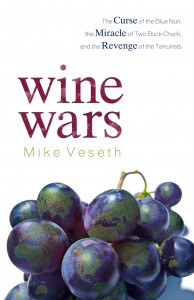 to the Prado museum, we stopped at a nearby restaurant for a quick lunch. I ordered the menu del dia, or menu of the day, a common offering at Spanish restaurants that generally features a soup or salad, an entrée, a desert and a choice of beverages. When I asked about the choice of beverages, I was offered soda of some kind, water, coffee, tea, or wine. Naturally, I asked for red wine, pleasantly surprised, but realistic enough to expect nothing more than a glass of something that would be innocuous at best.
to the Prado museum, we stopped at a nearby restaurant for a quick lunch. I ordered the menu del dia, or menu of the day, a common offering at Spanish restaurants that generally features a soup or salad, an entrée, a desert and a choice of beverages. When I asked about the choice of beverages, I was offered soda of some kind, water, coffee, tea, or wine. Naturally, I asked for red wine, pleasantly surprised, but realistic enough to expect nothing more than a glass of something that would be innocuous at best.
A few minutes later, the waiter brought a bottle to our table, set it down, and said something that I took to mean, “this bottle is all for you.” When I questioned him, he repeated the phrase. And I understood. Yes, it was mine, all mine. The entire bottle.
The meal probably cost 8 or 9 Euros, about $11 or $12 at the current exchange rate, at the bottom end of what I would expect to pay in any major U.S. city for a decent lunch at a nice, but inexpensive restaurant. Two things struck me about that transaction. First was the recognition that back home, the price of the meal would barely have covered a glass of wine, if that, along with a decent course or two of food. But what really surprised me was the casual way they threw in the full bottle. We’re talking wine, after all, not water from the tap.
I wondered off and on in the intervening years how it could be possible to serve a bottle of wine with a meal as though it was nothing more than a cup of bad coffee. Wine Wars gave me some answers.
Mr. Veseth discusses three major trends shaping the world of modern wine: globalization, “the miracle of Two Buck Chuck,” and what he refers to as “the revenge of the terroirists.” Continue Reading–>
Looking Back on the First Year
So, now that we’ve been through most of a full season, from preparing the ground and putting in the trellis, to planting and nurturing the vines all the way through the “harvest” (three clusters that grew despite our efforts to keep the vines free of fruit), I think it’s time to enjoy a glass of someone else’s wine, reminisce happily about how well everything turned out, and then get down to the serious business of evaluating what we did right and what we did wrong. On the plus side, I think we got a lot of things right. We spent more time than I care to remember researching and thinking through what varietals we would plant and more specifically, what clones would do best on our property – 740-feet above sea level, on a steep, westward facing slope in Afton. We settled on four grapes – Cab Franc, Petit Verdot, Viognier and Petit Manseng – and I’m very happy with the choices we made. We’re thinking of putting in some Merlot next spring, but I think the four we started with are great grapes for Virginia.
- My job was to dig the holes. . .
- In a more or less straight line.
- And my wife, the Vineyard Goddess, did most of the planting.
We decided to go with ENTAV clones, and worked through three different nurseries to get the vines we wanted. For the record, we ended up getting ENTAV 214 Cab Franc; ENTAV 573 Petit Manseng; ENTAV 400 Petit Verdot; and ENAV 642 Viognier. We put all of them on 101-14 rootstock. Continue Reading–>

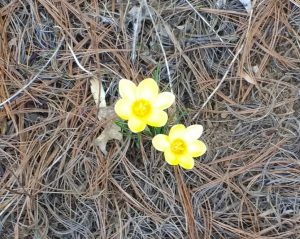
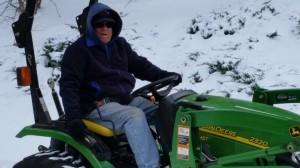
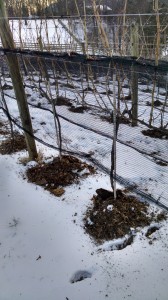
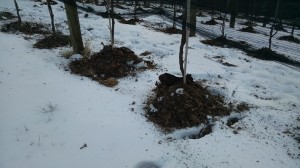
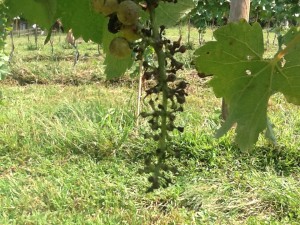
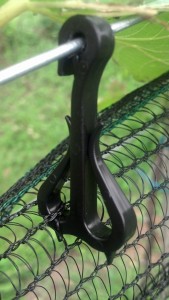
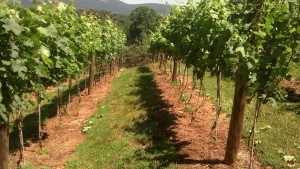
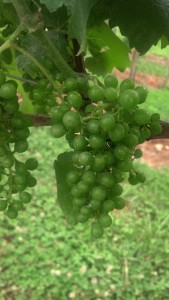
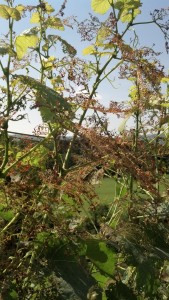
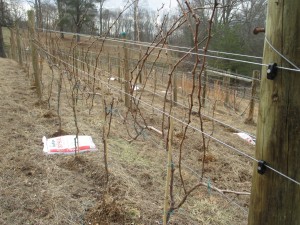
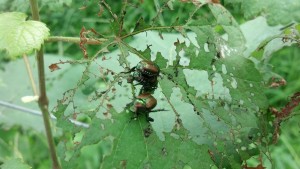
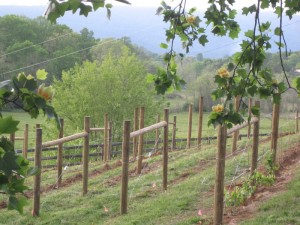
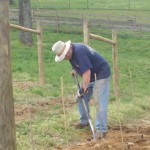
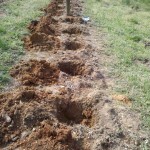
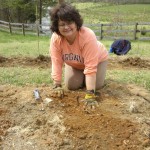


Recent Comments